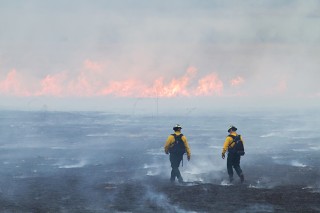
Curtis Callaway | Lecturer of journalism, public relations, and new media
University employees work to control Whitney fire
By Daniel C. Houston
Staff Writer
When firefighters with the Whitney Fire Department needed assistance last week controlling a series of fires that threatened more than 80 homes, they turned to two Baylor experts who helped them predict with accuracy when and where the fires were likely to spread.
Using computer models predicting the fire’s path and up-to-the-minute weather measurements, Dr. Joseph White, professor of biology, and Dr. Bruce Byars, staff member with the Baylor Center for Applied Geographic and Spatial Research, provided information that helped coordinate efforts to contain the fire.
The fire, which started Thursday afternoon approximately 30 miles northwest of Baylor, destroyed 10 homes and 25 outbuildings in the process of burning 580 acres of land, according to Jeff Moore, fire chief and emergency management coordinator for the city of Whitney.
Moore said the efforts of more than 28 fire departments aided by the assistance of White and Byars were able to save 75 homes.
By Friday morning, the fire had been contained to several “hot spots,” or relatively small fires that could flare up and spread given the right conditions, according to Curtis Callaway, full-time lecturer of journalism and media arts and Whitney resident who worked as a volunteer during the fire.
“Starting [Friday] at around 12 to 1 o’clock in the afternoon, the humidity was going to tank — drop — and the wind was going to pick up, and that’s when you start having flare-ups,” Callaway said. “And everything [White] said was going to happen happened. He pretty much read that fire really well. It was neat to watch.”
Most of the firefighters’ efforts were concentrated on preventing the fire from reaching the tree canopies and spreading across the Brazos River, at which point White’s computer model predicted the fire would have become much more difficult to contain.
“[The humidity], the wind and the fuels on the other side of the river were favorable for creating a second fire that would be equal in size to the original fire in a small amount of time,” White said.
“In other words, it would double in size in that day. Given that you have a very large natural-gas electrical generation plant across the river, it was important to stop that from happening.”
The firefighters, by focusing on key hot spots, successfully prevented the fire from crossing the river. Moore cited data collected by Baylor and the Whitney Fire Department indicating these techniques nearly doubled the effectiveness of fire-containing efforts.
“This information is new to a lot of different fire agencies across the state,” Moore said.
“It’s not new to the Whitney Fire Department because we’ve been working with Baylor for so long. We’re 90 percent more effective in controlling the fire with fire modeling and the weather monitoring set up.”
While White was responsible for advising the firefighters on the most effective ways to allocate their resources, Byars played a crucial role by reporting weather changes with the help of Baylor students whose identities the Lariat was unable to confirm.
Byars was not available for comment by Tuesday’s deadline.
“Bruce and I,” Callaway said, “we stayed up top with one of his students who was doing weather reports – he has a little remote weather station – and he was giving weather reports over the radio about every 10 minutes so the firefighters knew when the humidity was dropping and winds started picking up, and when to really be on alert for anything to flare up.”
But their contributions weren’t simply limited to providing expert information.
“One of my duties that day was to be on the fire line,” White said.
“I actually wound up digging holes and putting out fires by putting dirt on them or dragging burning logs into previously burned areas.”
Moore expressed gratitude for the efforts of the two Baylor experts, saying they greatly contributed to his ability to predict the spread of hot spots and allocate personnel effectively.
“If we hadn’t have had them, I don’t think we would have lost any more homes,” Moore said, “but it would have taken much longer to control the fires.”



